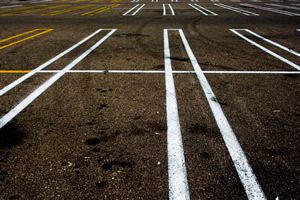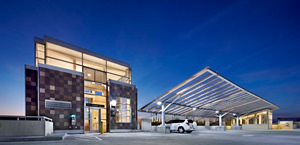RoboPark
 Back in the old days parking was a pain; too many drivers circling for too many minutes looking for too few spaces. Once a slot is found, the aggravated commuter scrounges for change to feed the meter, only to find a ticket on his windshield at the end of the day because the fee paid came up short. So maybe next time he’ll take the bus. But why isn’t that bus running on time? It’s cold out — or hot, or rainy — and he’s running late for class. Luckily technology offers solutions that turn boring old parking into an exciting new frontier.
Back in the old days parking was a pain; too many drivers circling for too many minutes looking for too few spaces. Once a slot is found, the aggravated commuter scrounges for change to feed the meter, only to find a ticket on his windshield at the end of the day because the fee paid came up short. So maybe next time he’ll take the bus. But why isn’t that bus running on time? It’s cold out — or hot, or rainy — and he’s running late for class. Luckily technology offers solutions that turn boring old parking into an exciting new frontier.
That’s right. Thanks to emerging technology, parking is the new sexy. Do you need to know where your best chances are of finding a space? There’s an app for that. Do you want to register for parking permits at 2 A.M? Just log in. Are you out of change for the meter? Pay by phone. Or ditch the car altogether and take the bus. New technologies pinpoint a fleet’s worth of locations and arrival times.
Rock Star Parking
Colleges and universities traditionally rely on a permit system to dole out space. And dole out they must, as parking remains inevitably scarce. “We have 7,000 parking spaces on campus and just under 20,000 students,” reports Cindy Campbell, member of the board of the International Parking Institute and associate director, University Police, California Polytechnic State University in San Luis Obispo. That number doesn’t take into account the some 3,000 faculty and staff members that also compete for space.
Registering for that permit used to mean lining up at the school’s parking office and paying with a check or credit card. The school then has to staff parking officers to patrol lots and grounds. “Ticketing and permit systems can cost the average-sized university between $30,000 and $50,000 a year,” says Bob Youakim, managing partner, Passport Parking.
Several advancements promise to streamline this process. The first is license plate recognition software, or LPR. “With LPR, the license plate stands in for the physical hangtag or permit,” explains Dan Kupferman, CAPP, director, Car Park Management Systems. “You can register your car online, anytime, anywhere.”
Now instead of staffing an army of parking attendants, one employee in one car outfitted with automatic vehicle recognition software (AVR) can patrol an entire campus. “Even isolated areas can become parking lots because the attendants are no longer on foot,” says Kupferman. This new technology doesn’t need to be cost-prohibitive. “We offer a cloud-based option that works off any Android device,” says Youakim.
But license plate permits don’t make it any easier to find a spot. “The average person spends 20 minutes a day circling for parking,” says Kupferman. “Parking guidance software can let people know if there are available spaces in the area.”
Automated parking guidance systems (PGS) work great in parking garages. Sensors constantly measure if a space is empty or occupied. That data can be sent to websites, apps or dynamic signage. “Price tags for the signs can run from a couple thousand dollars to $50,000,” continues Kupferman. A top-end sign could display a variety of messages, from coming events to advertising. While the technology exists to broadcast street parking, Kupferman advises caution. “You don’t want people looking at their phones while they’re driving and you don’t want lots of people racing to one space. It could encourage reckless driving or road rage.”
Game Day
These approaches help ease day-today parking woes, but what about when there’s a game? “We have 26,000 students, a stadium which sits in the heart of campus that holds 87,000, and 4,000 parking spaces,” reports Don Andrae, manager, Parking Services, Auburn University. If that wasn’t challenging enough, “We get another 10,000 to 20,000 tailgaters who just want to park as close to the action as possible.”
The Athletics department handles those 4,000 spaces on game day. Prime spaces go to big donors. RVs and motor homes take up more precious real estate. And one 600-space lot is dedicated to handicapped parking, which is free, providing you have the correct credentials.
How does Andrae make sure the lots are empty and ready to go? “Student cars will be towed if they are in a lot on a Friday before game day. To avoid this we send out between 14,000 to 15,000 emails advising students when and where to move their cars.” These emails are sent on the Monday, Wednesday and Thursday before game days. “It’s greatly cut down on the number of cars we have to tow, but we still tow more than I would like.”
Joshua Kavanagh, director of Transportation at the University of Washington, has a different approach. “We turn the four-lane road in front of the stadium into a transit plaza and run buses to a park-and-ride,” he reports. “We put about 16,000 people on public transportation that way.”
Bus of the Future
Kavanagh has a lot of experience with getting people on the bus. “At peak we have up to 3,000 empty spaces on campus,” he boasts. How did he do it? “We discourage daily parking permits by charging $1,600 a year for them. To encourage carpooling we charge 60 cents a day. But mostly we have a robust transit system with reduced rates for students.” That system encompasses eight agencies, including city and county buses, light rail, water taxis and ferries with payments all connected to one RFID-chipped card.
With GPS-equipped buses, riders can see exactly where their buses are and what time they will arrive at their stops. “For us this is a safety issue,” reports Chad Baldwin, University Public Relations, University of Wyoming. “We get extreme weather and don’t want riders exposed longer than they have to be.” Even if the weather is fine, however, knowing where your ride is makes taking the bus that much easier.
Add WiFi to the mix and the bus just got better. “It’s a common request,” says John Moscatelli, director of industry solutions, AT&T. “Now that there are 4G networks it makes the technology faster and easier to deliver.” Moscatelli also reports that schools are equipping buses with video-capture technology to make the ride safer. “Drivers can push the video feed to a school’s Safety department during an event,” he says.
Unpaving Paradise
Even with all of the advances and alternatives, parking remains a hot-button issue. “People resent paying for it,” says Campbell. What people don’t understand is that they are paying a subsidized rate. “If parking went for market price it would be much more expensive,” says Kupferman. Don Andrae agrees. “The going rate for a parking deck is $15,000 a space,” he says. “At that price I would have a hard time getting my school to green-light a new deck.”
Conversely, offering alternatives can give valuable real estate back to the school. “In my 20 years I’ve converted $71,000,000 in land from parking lots to space for new buildings or open areas,” says Kavanagh. “And we still provide parking to those that really need it.”
Award-Winning Parking at Duke University

PHOTO © JAMES WEST/JWESTPRODUCTIONS.COM
The International Parking Institute (IPI, www.parking.org) annually recognizes the industry’s most outstanding parking facilities and operations with its Awards of Excellence, citing innovation, efficiency, sustainability and user-friendliness as key factors in the selection. In 2012, a “Best Design of a Parking Facility with More than 800 Spaces” award was presented to the Duke University Research Drive Parking Garage in Durham, NC.
The 1,900-space, seven-story Research Drive Garage is the first stand-alone parking structure to be certified by the U.S. Green Building Council. Prior to the Duke certification, the USGBC had not recognized a freestanding, single-use parking garage as a certifiable building type. Serving Duke students, faculty, visitors and patients, the facility’s intuitive, functional design includes an exterior express ramp, flat floor plates with great flow capacity, unobstructed internal views and enhanced security.
University students, staff and faculty are given automotive vehicle identification (AVI) tags for efficient garage access. This identification control system for frequent parkers processes transactions in half the time of traditional insertion cards and about 25 percent faster than proximity cards, nearly eliminating idling at the garage entrance. Green growing walls designate entry/exit locations with (AVI) technology for regular users.
The garage’s second tier is reserved for university visitors and features a separate entry/exit. Upon exiting the facility, visitors use a pay-on-foot system with a central cashier rather than from an idling car — which is increasingly becoming the standard — reducing processing time at exits by 60 percent.
Space availability displays navigate parkers to open spaces. The garage’s dual-purpose architecture blends with surrounding buildings and incorporates green walls/roof canopies, terra cotta and stone panels and landscaped rain gardens.
This article originally appeared in the College Planning & Management October 2013 issue of Spaces4Learning.